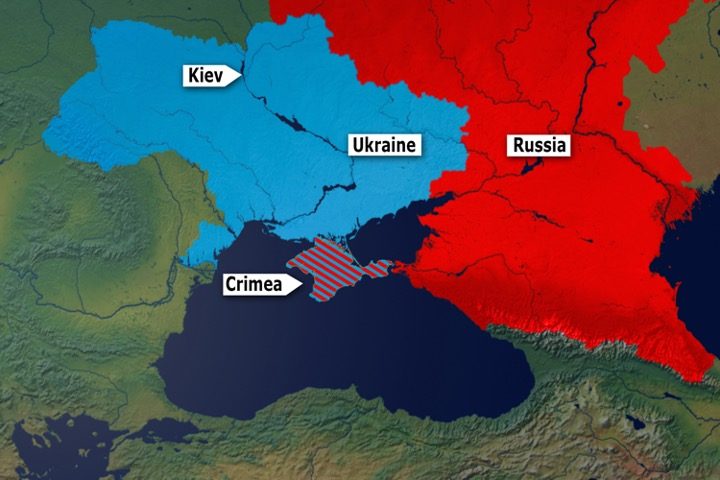
Ukrainian leader Volodymyr Zelensky has predicted that his country’s armed forces will “isolate” Crimea in 2024. The region, which joined Russia in 2014 after a brutal nationalist coup in Kyiv, is host to Moscow’s Black Sea fleet.
Kyiv will try to fend off access to the peninsula by destroying the Kerch bridge, which links it to the Russian mainland, Zelensky posited. For this aim, Zelensky has once again demanded German-made long-range Taurus cruise missiles, which Berlin has so far declined to supply even after France and the U.K. supplied Kyiv with Storm Shadow missiles.
Zelensky blamed information leaks for the failure of Kyiv’s much-hyped summer counteroffensive against Russia, but nonetheless shared new insights into the military’s top priorities for 2024, declaring in an interview with The Economist that alienating Crimea was “extremely important.”
The Ukrainian leader reinforced his goal of eventually restoring the country’s 1991 borders, but refrained from making any promises or setting timelines. The immediate goal, he said, will be “to defend the east” and guard Ukraine’s critical infrastructure.
“Russia has to know that for us this is a military object,” he said.
Based on statements by Russian President Vladimir Putin last month, Russian forces presently hold the strategic initiative in the Ukraine conflict, while Kyiv has largely been motivated by political goals, with their efforts aimed at showing “their true masters at least some results.”
Putin highlighted last month that Russia had no plans to alter the goals that it set for itself when it decided to mobilize troops against Ukraine in early 2022.
Characterizing the current situation, Putin said: “In the current situation ‘on the ground’, at the line of contact, we can say with confidence that our troops have the initiative.”
“In essence, we are doing what we consider necessary, what we want. Wherever … commanders decide active defense is best, it takes place. And where it is needed, we improve our positions,” he added.
Russian Defense Minister Sergey Shoigu hitherto estimated that Ukrainian casualties between early June and late November last year had exceeded 125,000, and during a Defense Ministry meeting last month, the ministry estimated Kyiv’s losses since the start of the hostilities to be over 383,000.
In the same interview with The Economist, Zelensky lamented that the “mobilization of Ukrainian society and of the world” was much lower now than at the beginning of the conflict, conceding that any military success will hinge on aid from the West. “Giving us money or giving us weapons, you support yourself. You save your children, not ours,” he alleged.
Kyiv declared a general mobilization in February 2022, banning most men aged 18 to 60 from leaving the country, but the campaign has been plagued by corruption and draft dodging.
“Mobilization is not just a matter of soldiers going to the front. It is about all of us. It is the mobilization of all efforts,” Zelensky told The Economist. “Let’s be honest, we have switched to domestic politics.… If we continue to focus on domestic politics, we need to call elections. Change the law, the constitution. But forget about counteroffensive actions and de-occupation.”
On January 3, a member of the Ukrainian defense industry’s new governing board, former economy minister Timofey Milovanov, broached the idea of using an American-style “lottery” as a solution to Kyiv’s conscription problems.
“Most of my readers write that the right approach to mobilization is through lottery or draw,” Milovanov posted on Facebook.
“The state [randomly] pulls out the day and the month. Those people born on these days mobilize, others don’t. And so it [goes] for every wave of mobilization,” he continued. “I don’t think this is the right approach, but what do you think?”
The post sparked over 1,000 replies going both ways, with more than one person stating that the United States had used this system during the Vietnam War, causing many wealthy people to buy their way out of the draft.
Earlier in the day, Forbes reported that Zelensky’s office was contemplating exempting from conscription those Ukrainians who earned 33,400 hryvnias ($875) or more per month.
The government in Kyiv is grappling to replace the losses in men and equipment in the country’s conflict against Russia. In August, Zelensky disbanded most regional draft boards after a massive corruption scandal involving the sale of fraudulent medical exemptions. Following Ukraine’s mediocre summer counteroffensive, the Ukrainian leader announced last month that the military had asked to draft another 500,000 men — and possibly women — a claim which was immediately denied by General Valery Zaluzhny.
Recently, Zelensky also appointed a new, five-person supervisory board for the state defense conglomerate Ukroboronprom. Among them was Milovanov, former minister of economic development and trade (2019-2020) and a lecturer at America’s University of Pittsburgh in Pennsylvania.
The board also includes an American citizen, Lynndy Smith, who is the CEO of the Arizona Defense and Industry Coalition (AZDIC). The outfit was set up by the late Senator John McCain, a vocal supporter of the 2014-backed coup in Kyiv that sparked the Donbass conflict.
Meanwhile, the Russian Defense Ministry announced that 248 of its service members were freed from Ukrainian captivity on January 3. For its part, Kyiv has claimed that 230 of its personnel have so far been exchanged with Moscow.
The swap of captured personnel was the culmination of a “complex negotiation process” facilitated by the “humanitarian mediation” of the United Arab Emirates, the Russian military proclaimed.
Liberated captives have been offered medical and psychological assistance, and will be transported home by Russia’s Aerospace Forces for treatment and rehabilitation in military medical facilities.
Shortly after the Russian announcement, Zelensky posted on his Telegram channel that “more than 200” Ukrainian servicemen had been released in exchange, later claiming the exact number was 230.
Neither side mentioned the other’s prisoners in their statements.
This week’s exchange is reportedly the largest during the entire Russo-Ukrainian conflict so far. The last public swap of prisoners was in early August 2023, entailing 22 soldiers from each side.


